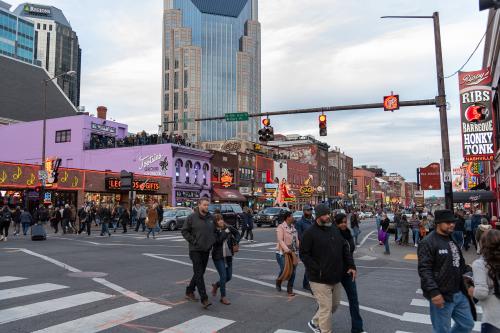I have been coming to Charlotte for 25 years, consulting for the likes of Crosland and Faison Enterprises, and have observed in Charlotte one of the most remarkable metropolitan transformations in the country. The economy has obviously changed, becoming one of the largest concentrations of U.S. financial institutions, thanks to the likes of Hugh McColl, Bank of America and Wachovia.
Your town has seen the metropolitan edge grow into South Carolina and up past Davidson. This sprawl is balanced by the splendor of uptown, or Center City, partially a benefit of McColl’s focus on your downtown.
I returned to Charlotte two weeks ago, courtesy of the Charlotte Region Civic By Design Forum, sponsored by AIA Charlotte, to see what has happened since my last visit and to give a speech about the structural shift in how the country is building its built environment. As I mentioned in a column in the Observer before I came (March 8, “Charlotte, walk this way”), the metro areas are changing from just offering the Ozzie and Harriet version of the American Dream and adding a “walkable urban” Seinfeld version as well.
So what did I see in Charlotte?
First, I saw the beginning of the end of sprawl. Like much of the rest of the country, the over-production of automobile-driven suburban development at the fringe of your metropolitan area has reached its limits. The combination of outrageous commutes, high gas prices, and the increasing number of consumers preferring a walkable urban way of life have combined to end the geometric increase in land consumption.
The sub-prime crisis has just accelerated an underlying trend. That trend demonstrates that a lifestyle predicated on cheap gas, subsidized infrastructure and long commutes could not last.
Walkable, urban places
But what is emerging to take its place?Metro Charlotte seems to be following a national trend in creating and growing high-density, walkable urban places. The opening of the Lynx light rail line to the south is showing the way. It starts in a re-energized Center City with the one-of-a-kind performing arts center, museums, high-rise temples of commerce, sports venues, a convention center, high-end hotels, the central library, among other regionally significant treasures. There is now a “there there” in Center City.
However, housing is the true sign that a downtown is viable. For years, the few urbanites in Charlotte found refuge in the Fourth Ward, one of the special places in the South. However, resilient, safe and racially and socially integrated housing districts have emerged in the First, Second and Third Wards, as well as the beginning of luxury high-rise living in the heart of Center City. There even are small grocery stores and some of the best dining in the region. You are seeing the emergence of a Big City.
But it definitely is not confined to Center City.
Downtown-adjacent places such as Southend, arts-focused places like NoDa, and emerging Elizabeth Avenue and Midtown all are providing rich options. Each of these places has its own character. These places offer a somewhat lower density, but still walkable urban, alternative to Center City.
There is going to be a major hurdle to transforming SouthPark into what it wants to be, an upscale walkable urban place like Winter Park in Orlando or Bethesda near Washington, D.C. It was built for the easy movement and storage of the car, and a decision will have to be made as to whether it wants to be a drivable place — or a walkable place. Right now, it is trying to be both, is neither fish nor fowl, and this will fail. The fact that there are no plans for rail transit nearby is just one of many signs that it is a very confused area.
Metro Charlotte’s future
Regardless of whether SouthPark figures out what it wants to be when it grows up, there will be 8-10 regionally significant, walkable urban places to develop in Metro Charlotte over the next two decades. Each will have a unique character and different density. What they will have in common is that they are walkable (also bikable) for most residents’ everyday needs and maybe even employment.
Only four or five have begun to germinate so far. SouthPark should be on that list but won’t be until it solves its identity crisis. Where will the others emerge? Best bet is to follow the rails. Most will be anchored by a transit station.
I think I have seen the future of Charlotte. Continue to build out the light-rail system and encourage mixed-use, high-density zoning around the stations. You will find that your extraordinary growth of the past generation will continue but in a new and different manner since the market demands different options. You will also find that this new kind of growth will be economically, financially and environmentally more sustainable.


Commentary
Op-edNew Kind of Growth Emerging for Charlotte
March 29, 2008